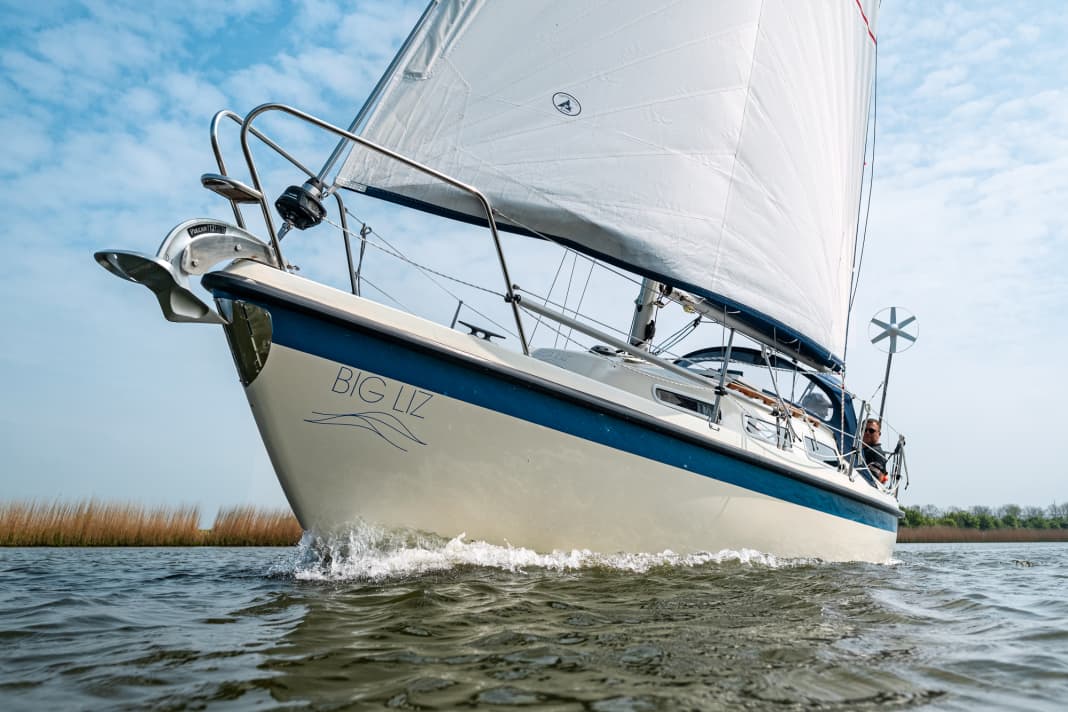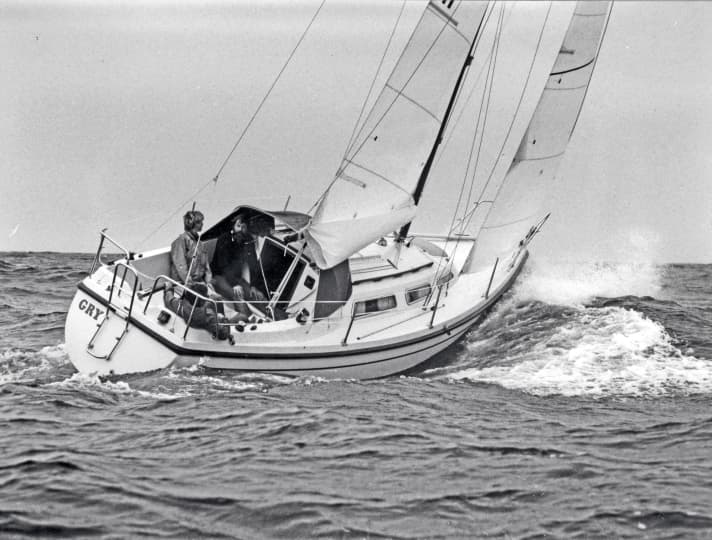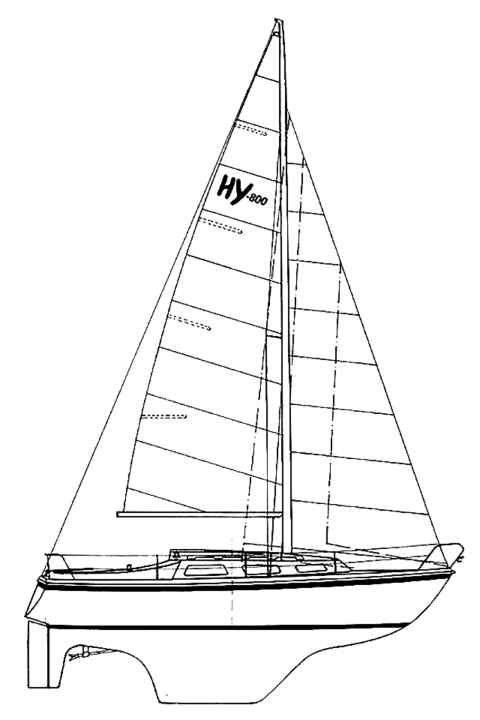





These are the days: twelve knots of wind, sunshine, pleasant warmth. That's why you sail. In this case, the trial run also marked the final and happy conclusion of a very extensive refit. It took place in the garden in Düsseldorf under a tent and with great participation from the tolerant neighbourhood.
Afterwards, owner Sven Messner wasn't sure whether he wanted to travel the long distance to the Netherlands by trailer. After all, the unladen weight was around three tonnes and there were a few extra things on board. So Messner waters the Hurley in the harbour in Düsseldorf. From there, it travelled down the Rhine and the IJssel towards Holland on a single-cylinder diesel engine.
Everything goes well, after all, the Bukh has been refurbished and is actually indestructible anyway. After the last bridge, the mast comes on board. Then the new sails and, and, and. You know the drill. Finally the information: everything works, the ship is ready for a trip. And then the weather. Great.
The Hurley 800 has 44 per cent ballast
She feels at home on the Johan Friso Canal. The height is fine, the wind is slightly gusty due to occasional bushes on the shore. The Hurley handles this with the composure of a much larger yacht, tracking true to course and with the right amount of rudder pressure. No wonder, as 1.4 of the three tonnes of total weight are ballast. Just under 44 per cent is a lot. Incidentally, the ballast is inserted from the inside into the keel, which is firmly laminated to the hull, and then moulded over with resin. This is a very solid and durable process.
The high ballast ratio fits in well with the boat's other features: the halyards are all deflected into the cockpit, which in turn is framed by very high coamings. This gives an enormous feeling of safety for an eight metre long boat. At the same time, however, the yacht also handles as if it were "only" an eight-metre boat. This is because it is manoeuvrable on the narrow canal, never difficult, sometimes starts well, which is perhaps also due to the well-fitting, brand-new cloths, and travels at a decent height. This manoeuvrability is pleasing and takes the seriousness out of the whole sailing experience. It's simply fun - literally. Sailing on the Hurley can be summarised quite briefly: simple, safe and agile.
But what makes this Hurley 800 such a special boat? Clearly the owner. He has already spent quite a while with his "Liz", but only with work. And he still has a lot planned for her. After he has finished refitting his first Hurley, a 22, his wife dies. The boat is full of memories, it has to go. The new one, an 800, is "big" in comparison. It arrives in pretty good condition, but a lot has to change for his plans. Messner plans. That's the be-all and end-all of a refit anyway - planning. He measures and tinkers, sometimes for nights on end, until everything fits in theory. Then his craftsmanship comes into play. One example: There is a kind of pull-out larder unit in the pantry. Not only is it designed around the Tupperware containers for muesli and pasta, it also only goes a millimetre past the handrail in front of the cooker.
Hurley 800: a used boat tip

Solid, good sailing, safe, separate toilet room and still trailerable: this is as rare as it is popular. Most second-hand boats are traded in the Netherlands, where they cost between 15,000 and 25,000 euros. The single-cylinder bukh indicates a ship from the Danish shipyard. It is considered to be very robust and spare parts are available. Ships built in Holland usually had a Vetus two-cylinder engine. Later models with a round transom were called Hurley 830; the hull is the same. A few ships have a draught of only 1.25 metres. As the Hurley was offered for self-construction, pay particular attention to the quality; the layout is also often different. No serious problems are known.
One third of the time for planning, one third for procurement and one third for the construction of the Hurley
He made the cabinet months before it was installed. And it fitted perfectly. "For example, you have to pay close attention to how much the fittings are built up. The timber construction also has to fit perfectly," reports the owner. And yes, it fits. However, you have to resist the temptation to tear everything out first: "The ship was on the trailer during the refit. If you remove structural components, it will warp." So he builds piece by piece from the bow to the stern. This also shows the importance of planning. Because you always have to know what's coming next in order to be prepared. Otherwise, some components won't fit together afterwards.
Messner works his way through the ship piece by piece. He plans, researches parts and builds. "The procurement takes just as long as the planning and building. The pandemic hasn't necessarily helped with the availability of parts. And I didn't make any compromises, preferring to wait and do something else in the meantime," says the ambitious hobbyist. He adds: "It really helped that I sometimes had a dozen sub-projects running. Things were always moving forward somewhere, even if parts were missing here and there."
And so the Hurley is turned inside out. The engine comes out for a refit, the engine compartment is completely renovated, everything is now clean and perfectly insulated. And well lit, of course. Keyword electrics: this is also completely renewed. And although the owner describes himself as "not particularly gifted in electrical engineering", the result is impressive. Most shipyards would probably be delighted if their electrical systems were similarly neat and tidy. Solar cells and a wind generator provide sufficient power when travelling. This is stored in a battery directly in front of the companionway in the bilge. This is the location that the shipyard has chosen for this: deep and in the centre of the ship. In this way, the battery contributes to stability.
The Hurley has room for four to sit and two to live
Incidentally, according to the shipyard brochure, 80 per cent of the engine is also located below the waterline and thus also ensures a righting moment. It fits into the picture that the deck is made of a foam sandwich construction. This also reduces the weight. The hull itself is solidly laminated using the hand lay-up method. The two are joined together under the very solid rubber rubbing strake. Of course, the whole thing is laminated on the inside - the transom is part of the fuselage. All this makes the construction rigid and tight.
Inside, the saloon has been visually subdivided by cleverly placed partitions in the lines of sight. There is the galley and the navigation system aft, which can even be used as such, and the saloon in front. There is space for four to sit, but essentially for two to live. Sitting comfortably on the benches, you can watch TV on the tablet. The tablet can be used for this on one side of the viewing wall in the Navi. In the holder on the other side, it becomes an entertainment device.
A small detail, but one that shows Messner's approach: How can you make optimum use of which space? He must have spent hour after hour working out such details. The result is an interior that is unrivalled. An eight-metre boat with the fittings of a yacht, the quality of which has nothing to hide from the greats of interior design. Solid, matt surfaces, no half solutions anywhere, everything is perfectly finished. No one else builds a yacht of this size. Especially not fully customised, precisely tailored to the owner's requirements. Truly special.
Hurley as a product of Dutch series production
The Hurley 800 is actually a product of series production. Its history began as the Junker 26 in 1977, when Arne Borghegn's design struck a chord. Over the next four years, 146 were built in Denmark. That is quite a lot. From 1981 onwards, the Holstebro Plastværk shipyard delivered a further 100 or so ready-built boats to the Holland Yachting shipyard, which took over the sale of the boats and gave the yacht the name Hurley 800.
The Danish-built units have a Bukh diesel engine and 1,400 kilograms of iron ballast as well as a foam sandwich in the deck. From 1985, the yacht is built by the Dutch themselves. The GRP work was outsourced to various shipyards. Even Conyplex in Medemblik, now Contest Yachts, built some of the hulls. The ballast is reduced to 1,250 kilograms, and in addition to the standard draught of 1.40 metres, a variant with 1.25 metres and the same ballast is also offered. Because it was lighter and from the Netherlands, the Hurley was now powered by a Vetus two-cylinder engine.
Over the years, a further 160 ships were built. Construction number 402 marks the end. By then, the rights already belonged to Jachtbouw de Eemhof near Almere. In later years, the ship was also offered as the Hurley 830 with a slightly different interior layout. The hull was, of course, the same, because it was also good. A little more swing in the transom and the ship was 30 centimetres longer on deck. The long keel and the rudder on the full skeg ensured good-natured sea behaviour. The idea of a solid ship is also reflected in the laminate thicknesses: 14 millimetres below the waterline, 11 above. The keel area is 18 millimetres thick and the keel sole is 25 millimetres thick. Solid laminate, mind you.
This is well known: A Hurley causes few problems
6 millimetre thick aluminium plates are inserted in the deck where the fittings are located. Soft decks are actually unknown. Just as there are generally few problems with the Hurleys. The brochures from the eighties all point to the good resale value. And rightly so. Because the owners are also loyal souls. An active community has formed, at least in the Netherlands. They love their boats. In one forum, an interested party asks whether it is possible to sail around Cape Finisterre with a Hurley. The answer from an owner is clear: if it is in good condition, you can sail it anywhere.
Owner Messner Messner has the same plans. He has long been a fan of the Subaru brand. As a member of the Subaru Club Germany, he has many contacts in Japan: "I want to go there. It's a great sailing area there. And you can't charter there, as far as I know. So on my own keel." His "Big Liz" can do that. She is in good condition. All the fittings are fresh, a new mast has been ordered and everything else is fine. The size is not a problem, after all, a smaller ship would be much easier to get in touch with the local people.
Hurley has three target groups
But the Hurley can also be a good companion for those who are not pursuing such distant goals. The solid construction, the high ballast ratio, the deep cockpit and the successful layout of the interior speak in favour of this. After all, it offers 1.83 metres of headroom, a separate toilet area and sufficiently large berths. This makes the Hurley particularly suitable for three target groups: older owner couples who no longer want to travel so far from home, but still want to keep sailing. The comfort is sufficient, the sailing characteristics safe, the forces manageable even in old age.
The second target group is young couples who are perhaps just starting to sail and are looking for a boat that initially raises few questions and has a solid appearance, and which is therefore still capable of being a loyal companion when their wanderlust grows. The third target group is young families. The first offspring has arrived, and life requires so much attention that the boat needs to be simple and uncomplicated. The Hurley can do that too. This shows that designer Borghegn has conjured up a truly versatile design on paper. Sven Messner also recognised this and turned his "Liz" into a jewel.
Technical data of the Hurley 800

- Other type names:Junker 26, Hurley 830
- Design engineer:Arne Borghegn
- Torso length:8,00 m
- Width:2,70 m
- Depth:1,40 m
- Weight:3,2 t
- Ballast:1,4 t/44 %
- sail area:35,1 m2
- Sail carrying capacity:4,2
- Motor:Bukh 10 hp or Vetus 11 hp
- Standing height:1,85 m
- Bunk forward:1.90 x 1.70 m
- Saloon berths:2.05 x 0.70 m
- Dog bunk:1.95 x 0.65 m
Other special boats:
- "Trout from Kollmar" :Return of a historic gaff cutter to Büsum
- "Wanderer III": A cruising yacht classic and the 96th degree of longitude
- "Gloria: Retro-One-Off mixes classic timber construction with high-tech

